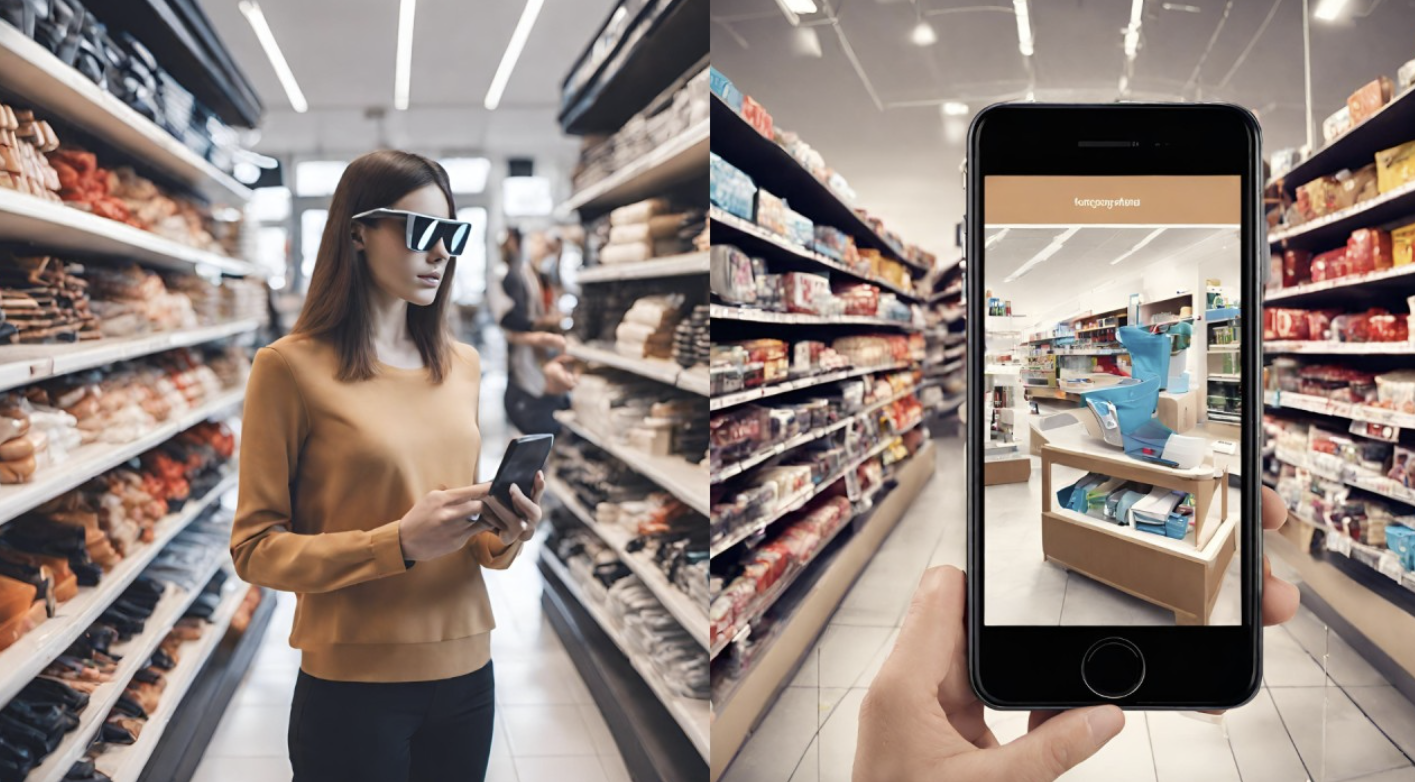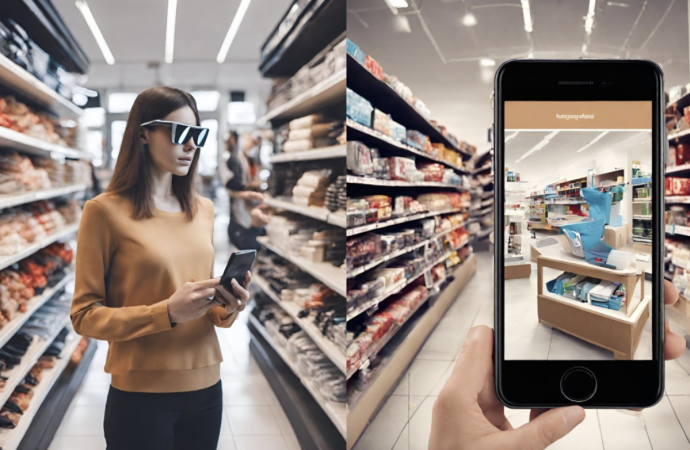Augmented reality (AR) has quickly moved from a fun tool for games and novelty apps to an essential part of the retail experience, both online and in physical stores. AR helps shoppers make more confident buying decisions by providing quick insights and visual previews. As a result, customers are happier with their purchases, and brands

Augmented reality (AR) has quickly moved from a fun tool for games and novelty apps to an essential part of the retail experience, both online and in physical stores. AR helps shoppers make more confident buying decisions by providing quick insights and visual previews. As a result, customers are happier with their purchases, and brands experience fewer returns.
This shift didn’t happen overnight. Only in recent years have smartphones, better internet, and more advanced software made AR accessible to large audiences. Now that both e-commerce giants and local stores are adopting AR technology, shoppers expect these features more than ever. The real appeal of AR is how it blends the best aspects of traditional and digital shopping: you get the tactile and visual cues of in-person shopping, plus the convenience and data-driven insights of online platforms. In this article, we’ll explore how AR is changing different parts of the shopping journey, including fitting rooms, interior design, in-store experiences, and more, while also looking ahead to the future of AR in retail.
AR: A Quick Overview At its core, augmented reality overlays digital elements—like images, text, or animations—onto the real world around you. Unlike virtual reality (VR), which immerses you completely in a digital world, AR keeps you grounded in the physical world. Using your smartphone or AR glasses, AR detects surfaces and movement and merges virtual content with your surroundings. Early examples included games like Pokémon GO and fun social media filters. But in retail, AR goes beyond entertainment and serves practical purposes, like letting you try on makeup virtually or see how a piece of furniture fits in your home. What makes AR so appealing is its ease of use—just point your device at what you want to see, no heavy headsets or fully virtual environments required. This simplicity is why it’s caught on in commercial settings.
As technology improves, AR experiences are becoming more realistic and easy to use on everyday devices. 3D scanning and better visual recognition ensure that virtual items stay in place without glitches, and some apps even account for lighting effects, making virtual furniture look like it’s in your actual room. The more lifelike AR becomes, the more confident shoppers feel about their decisions. This combination of convenience and believability is what makes AR so powerful in retail, helping bridge the gap between “What if?” and “Yes, that’s it!” for a variety of products.
Virtual Fitting Rooms: More Options, Less Time One of the most popular ways AR is transforming retail is through virtual clothing try-ons. Instead of trying on outfits in a cramped dressing room, shoppers can use an app or an in-store smart mirror to see how clothing might look on them. The software uses your camera feed to track your body and superimpose the garment on your image. Some apps even simulate how fabrics move or drape in real-time. AR makes it easy to flip through different styles quickly, saving time and hassle in busy stores. Plus, it reduces the need to touch clothes that might get wrinkled or need constant re-hanging.
Online stores benefit too. Anyone who’s ordered clothes online knows the struggle of sizing and returns. AR try-ons reduce this guesswork. When an app measures key body points, it can display how a top or pair of jeans might look on you, giving you a better sense of fit. While it’s not perfect (especially for more form-fitting clothes), it’s often good enough to make initial selections. According to a 2021 study by Retail Dive, adding AR try-on features led to a 25% decrease in returns for items that used the feature—a clear sign that AR addresses real concerns in fashion shopping.
Makeup and Beauty: Try Before You Buy Without the Mess AR has also made a splash in the beauty world. Gone are the days of testing dozens of lipstick shades or experimenting with makeup testers in stores. With AR-powered makeup apps, you can try on different shades or styles simply by using your front-facing camera. The app scans your face and overlays the chosen product—whether it’s lipstick, eyeshadow, or even brow shapes—right on your live image. It’s a quick, hygienic way to see if that bold red lipstick works for you or if a more subtle pink suits you better. This also simplifies the long and tedious process of finding the right foundation shade.
Brands like L’Oréal, Maybelline, and Sephora have integrated AR features into their apps or store tablets, allowing users to blend and layer different looks to see how they might appear for a big event. These features aren’t just fun; they boost consumer confidence, which can lead to higher sales. A study by Perfect Corp found that customers who used virtual makeup apps made purchases 2.5 times more often. Additionally, this AR technology helps during times when hygiene is a concern, as it eliminates the need for testers that might feel unsanitary. In short, AR is revolutionizing the beauty industry by making the shopping experience both fun and practical.
Furniture and Home Decor: Visualize Before You Buy One of the biggest challenges in home decor is imagining how a piece of furniture will look in your space. AR solves this problem by letting you visualize products in your own home before making a purchase. IKEA’s app, IKEA Place, allows you to place life-sized 3D models of furniture in your living room, bedroom, or kitchen. Other retailers like Wayfair and Amazon offer similar tools that let you preview various items, from rugs to light fixtures, with just a tap.
This technology helps reduce the hassle of returns, especially for large items like furniture, which can be expensive and time-consuming to send back. By letting shoppers visualize items in their homes before buying, AR makes it easier to choose the right products. Plus, it’s an engaging experience—shoppers can test different styles and see how things look together, which leads to higher brand loyalty and satisfaction. A 2024 Forbes report showed that stores that implemented AR shopping options saw increased sales, as customers felt more confident buying after seeing how items looked together in their homes.
In-Store Engagement: Turning Shopping into an Experience In addition to e-commerce, physical stores are using AR to stay relevant in the digital age. Some stores offer AR mirrors or screens that suggest complementary items when you pick up a product. For example, scanning a shirt’s barcode might instantly show matching jeans or accessories on the screen. Other stores create fun, gamified experiences, where scanning hidden AR markers unlocks discounts or product information. These interactive features encourage customers to explore the store and stay longer, which can lead to impulse buys or make the shopping trip more memorable.
Grocery stores are also getting in on the action, using AR to show detailed nutritional information on products like cereal boxes. Sports equipment stores might use AR to show live action replays or brand endorsements above certain products. The goal is to turn a simple shopping trip into an immersive experience—something that can increase customer engagement and loyalty. However, for AR to be effective in-store, it needs to enhance the shopping experience without overwhelming it.
Brand Loyalty and Personalized Marketing Another benefit of AR is how it can enhance brand loyalty programs. Imagine scanning your loyalty card with an AR app and unlocking fun rewards like digital confetti or special offers based on your purchase history. These interactive features make loyalty programs feel more exciting and dynamic.
AR also allows for deeper personalization. For example, if you frequently try on athletic shoes using an AR fitting feature, the retailer might push a notification about a limited-edition sneaker release. Similarly, if you often browse mid-century modern furniture, you could see an AR visualization of a room styled with mid-century flair, along with product recommendations. This combination of data analytics and interactive visuals helps retailers offer personalized experiences that resonate with each shopper.
Social Sharing and Influencer Collaborations AR’s influence doesn’t stop with the shopping experience—it also makes it easier to share and interact on social media. After trying on an outfit using AR, shoppers might share a screenshot on Instagram or TikTok to get opinions from friends. Some retailers have made it simple to share AR experiences directly to social platforms, increasing brand exposure and making customers feel part of a fun, interactive community.
Influencers are also using AR to create more engaging content for their followers. With AR, they can offer a more interactive and dynamic experience than static photos or videos. This boosts brand visibility at a low cost to retailers, as influencers share creative content that sparks conversation.
Sustainability and Ethical Considerations Interestingly, AR can also help reduce environmental impact by cutting down on the need for physical samples. For instance, a home improvement store might use AR to show how different countertops would look in your space, instead of needing large physical samples. Similarly, clothing brands might use AR to showcase new lines, reducing waste from unsold samples. However, there are some environmental concerns, such as the energy costs of AR experiences and e-waste from frequent device upgrades.
Ethically, there are questions about whether AR cluttering public spaces with digital content could lead to distractions or overload people with marketing messages. Experts suggest that AR should be used in moderation to remain helpful without overwhelming users with ads. Retailers should focus on features that help customers make informed decisions rather than bombarding them with digital promotions.
Future Outlook: AI-Driven AR and Seamless Integration Looking ahead, experts predict that AR will merge even more with artificial intelligence (AI). Imagine trying on a digital dress, and an AI system instantly suggests matching shoes or hairstyle options based on your preferences. This “smart AR” experience will offer real-time personalized recommendations, guiding you from interest to checkout faster. Another exciting possibility is co-shopping, where two people in different locations could both view a product through AR, sharing their thoughts and experiences as if they were shopping together in person.
Rediscover Retail with AR Augmented reality is not just a passing trend—it’s changing how we shop. Whether it’s trying on makeup, visualizing furniture in your home, or enhancing in-store experiences, AR is making shopping more interactive, enjoyable, and informed. For businesses, it helps reduce returns, increase engagement, and gather valuable data. For shoppers, it makes decision-making easier and encourages trying new things without the risk. While there are challenges like cost and privacy concerns, as technology improves and AR becomes more common, it’s set to become a key feature of modern shopping.
In a world where e-commerce was dominating, AR is bringing people back into physical stores by offering digital experiences that enhance the shopping process. At the same time, it improves online shopping with real-time previews, bridging the gap between in-person and online shopping. Whether you run a small boutique or a large retailer, or you’re just curious about new technology, AR is showing us a future where shopping is more immersive, efficient, and fun.

















Leave a Comment
Your email address will not be published. Required fields are marked with *